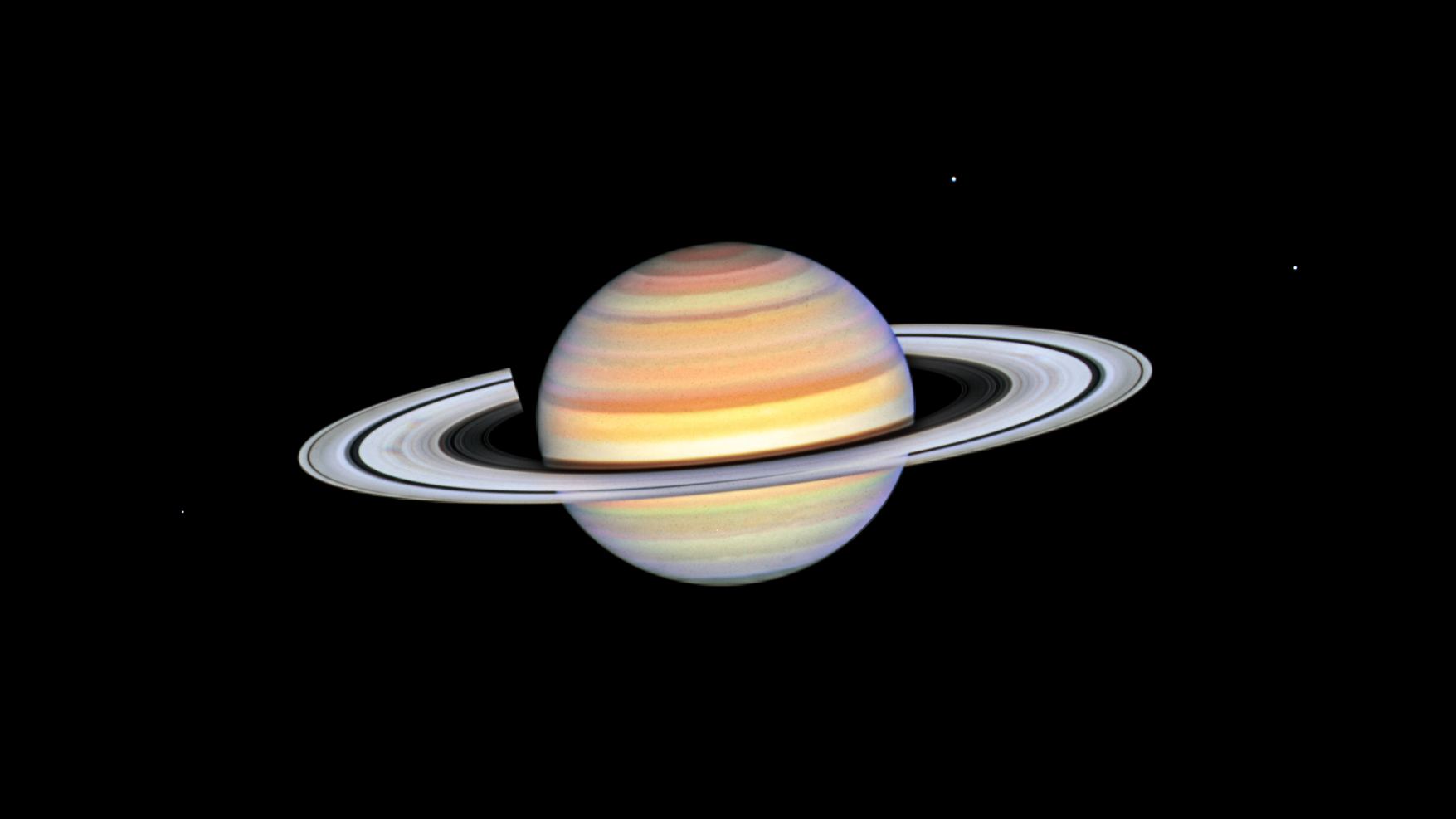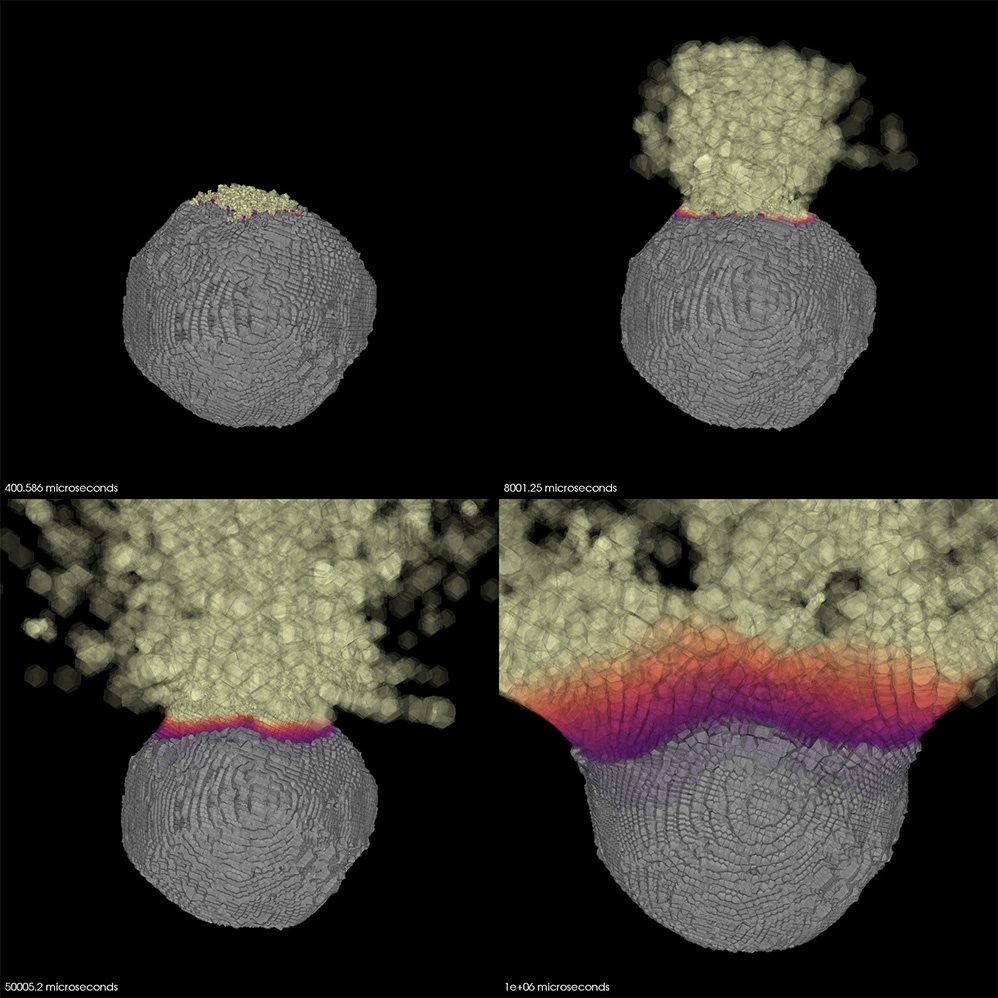On December 14th, at 12:02 PM Eastern (09:02 AM Pacific), the Sun unleashed a massive solar flare. According to the Space Weather Prediction Center, part of the National Oceanic Atmospheric Administration (NOAA), this was the strongest flare of Solar Cycle 25, which began in 2019 and will continue until 2030. What’s more, scientists at the SWPC estimate that this may be one of the most powerful solar flares recorded since 1755 when extensive recording of solar sunspot activity began.
Continue reading “We Just had the Strongest Solar Flare in the Current Solar Cycle”It’s Time for Saturn’s “Spokes” to Return

Astronomers have been observing Saturn with the Hubble Space Telescope and several other spacecraft for decades and have noticed something unusual. During seasonal changes, transient spoke-like features appear in the rings. These dark, ghostly blobs orbit around the planet 2-3 times, and then disappear.
As Saturn is approaching its equinox, this is prime spoke activity time. Once again, Hubble has been called to gaze at Saturn, tracking the behavior of the spokes and hopefully giving astronomers more clues as to why they occur.
Continue reading “It’s Time for Saturn’s “Spokes” to Return”Finally. A Productive Use for Nuclear Weapons: Asteroid Defense

While it has been a favorite disaster movie theme, nuking an incoming asteroid in the real world has been touted as a very bad idea. While a nuclear bomb could possibly obliterate a smaller asteroid, nuking a larger asteroid would only break it into pieces. Those pieces would still threaten our planet, and perhaps even makes things worse by producing multiple impacts across the planet.
But is using nuclear weapons on an incoming asteroid really a bad idea? If the right technique is used, a nuclear blast could possibly be used as an asteroid deflection device.
Continue reading “Finally. A Productive Use for Nuclear Weapons: Asteroid Defense”Why the Universe Might be a Hologram

A quarter century ago, physicist Juan Maldacena proposed the AdS/CFT correspondence, an intriguing holographic connection between gravity in a three-dimensional universe and quantum physics on the universe’s two-dimensional boundary. This correspondence is at this stage, even a quarter century after Maldacena’s discovery, just a conjecture. A statement about the nature of the universe that seems to be true, but one that has not yet been proven to actually reflect the reality that we live in. And what’s more, it only has limited utility and application to the real universe.
Continue reading “Why the Universe Might be a Hologram”It Doesn't Take Much to Get a Runaway Greenhouse Effect
During the 1960s, the first robotic explorers began making flybys of Venus, including the Soviet Venera 1 and the Mariner 2 probes. These missions dispelled the popular myth that Venus was shrouded by dense rain clouds and had a tropical environment. Instead, these and subsequent missions revealed an extremely dense atmosphere predominantly composed of carbon dioxide. The few Venera landers that made it to the surface also confirmed that Venus is the hottest planet in the Solar System, with average temperatures of 464 °C (867 °F).
These findings drew attention to anthropogenic climate change and the possibility that something similar could happen on Earth. In a recent study, a team of astronomers from the University of Geneva (UNIGE) created the world’s first simulation of the entire greenhouse process that can turn a temperate planet suitable for Life into a hellish, hostile one. Their findings revealed that on Earth, a global average temperature rise of just a few tens of degrees (coupled with a slight rise in the Sun’s luminosity) would be sufficient to initiate this phenomenon and render our planet uninhabitable.
Continue reading “It Doesn't Take Much to Get a Runaway Greenhouse Effect”Enjoy the Holiday-Themed Christmas Tree Cluster

Just in time for the holidays, a new composite image of the Christmas Tree Cluster (NGC 2264) has been released. This image is a group effort: the blue and white stars in the cluster giving off X-rays are seen by Chandra, while the faint green nebula was imaged by the WIYN 0.9-meter telescope on Kitt Peak.
Continue reading “Enjoy the Holiday-Themed Christmas Tree Cluster”Astronomers Find the Birthplaces of Stars in the Whirlpool Galaxy
Understanding how star-forming works at a galactic scale is challenging in our Milky Way. While we have a general understanding of the layout of our galaxy, we can’t see all of the details head-on like we would want to if we were exploring a single galaxy for details of star formation. Luckily, we have a pretty good view of the entirety of one of the most famous galaxies in all of astronomy – M51, the Whirlpool Galaxy. Now, a team of researchers from the Max Planck Institute for Astronomy has completed a survey of molecules throughout the galaxy and developed a map of potential star-forming regions.
Continue reading “Astronomers Find the Birthplaces of Stars in the Whirlpool Galaxy”The Strangest Coincidence in Physics: The AdS/CFT Correspondence

Attempts to turn string theory into a workable theory of nature have led to the potential conclusion that our universe is a hologram: that what we perceive as three spatial dimensions is actually composed of only two. The greatest realization of this hologram-led program is a proposal that goes by the awkward and clunky name of the AdS/CFT correspondence, first proposed by string theorist Juan Maldacena in the late 1990’s.
Continue reading “The Strangest Coincidence in Physics: The AdS/CFT Correspondence”A New View of Uranus’ North Pole from JWST
One cool thing about Uranus is that its orientation, compared to the rest of the solar system, allows a unique perspective of the planet from our home planet. It is tilted at 98° compared to the rest of the ecliptic plane. So, when viewed from Earth, we can see its North Pole and its rings in some exceptional cases. That perspective is fully displayed in an image of Uranus recently released by the European Space Agency (ESA) and captured using the James Webb Space Telescope (JWST).
Continue reading “A New View of Uranus’ North Pole from JWST”Blue Origin’s New Shepard Completes 24th Flight; New Glenn Hopefully on the Horizon
Blue Origin’s New Shepard rocket successfully launched and landed today at the company’s Launch Site One in West Texas, with an uncrewed science and goodwill payload onboard. This was the 24th New Shepard flight and 13th payload mission today from Launch Site One in West Texas.
This marked the first flight since September of 2022 when the uncrewed NS-23’s booster suffered an in-flight anomaly; however, the escape system jettisoned the capsule, which was able to land safely. With the success of NS-24, Blue Origin hopes to soon restart its commercial passenger flights.
Continue reading “Blue Origin’s New Shepard Completes 24th Flight; New Glenn Hopefully on the Horizon”




